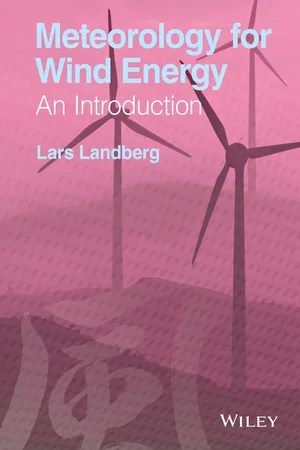
- English
- ePUB (mobile friendly)
- Available on iOS & Android
About this book
Most practitioners within wind energy have only a very basic knowledge about meteorology, leading to a lack of understanding of one of the most fundamental subjects in wind energy. This book will therefore provide an easy-to-understand introduction to the subject of meteorology, as seen from the viewpoint of wind energy.
Catering for a range of academic backgrounds, the book is mathematically rigorous with accessible explanations for non-mathematically oriented readers. Through exercises in the text and at the end of each chapter the reader will be challenged to think, seek further information and practice the knowledge obtained from reading the book.
This practical yet comprehensive reference will enable readers to fully understand the theoretical background of meteorology with wind energy in mind and will include topics such as: measurements; wind profiles; wakes; modelling; turbulence and the fundamentals of atmospheric flow on all scales including the local scale.
Key features:
• Provides practitioners of wind energy with a solid theoretical grounding in relevant aspects of meteorology enabling them to exercise useful judgment in matters related to resource estimation, wind farm development, planning, turbine design and electrical grids.
• Supports a growing area of professional development with the increasing importance of wind energy estimation in all aspects of electrical energy production from wind.
• Accompanying website includes data sets for exercises in data analysis, photographs, animations & worked examples, helping to further bridge the gap between theory and practice.
Meteorology for Wind Energy: An Introduction is aimed at engineers, developers and project managers in the wind power and electrical utility sectors without the essential theoretical background required to understand the topic. It will also have significant appeal to senior undergraduate and postgraduate students of Wind Energy, Environmental Studies or Renewables Studies.
Frequently asked questions
- Essential is ideal for learners and professionals who enjoy exploring a wide range of subjects. Access the Essential Library with 800,000+ trusted titles and best-sellers across business, personal growth, and the humanities. Includes unlimited reading time and Standard Read Aloud voice.
- Complete: Perfect for advanced learners and researchers needing full, unrestricted access. Unlock 1.4M+ books across hundreds of subjects, including academic and specialized titles. The Complete Plan also includes advanced features like Premium Read Aloud and Research Assistant.
Please note we cannot support devices running on iOS 13 and Android 7 or earlier. Learn more about using the app.
Information
1
Introduction

Table of contents
- Cover
- Titlepage
- Copyright
- Dedication
- About the Author
- Foreword
- Preface
- Acknowledgements
- List of Abbreviations
- Chapter 1: Introduction
- Chapter 2: Meteorological Basics
- Chapter 3: Measurements
- Chapter 4: The Wind Profile
- Chapter 5: Local Flow
- Chapter 6: Turbulence
- Chapter 7: Wakes
- Chapter 8: Modelling
- Chapter 9: Conclusion
- Appendix A: Cheat Sheet
- Appendix B: Answers to Exercises: Appendix B: Answers to Exercises
- Appendix C: Sample Wind Speed and Direction Data
- References
- Index
- EULA